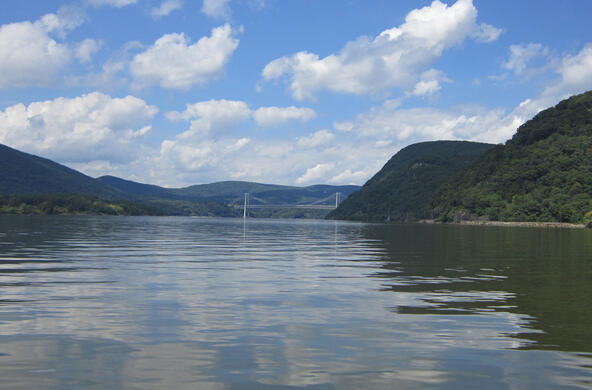Representatives from the Cary Institute of Ecosystem Studies and the New York State Department of Environmental Conservation (NYSDEC) unveiled an interpretive sign on the Walkway Over the Hudson River. An audience of media and citizens heard commentary about the new sign, which features river monitoring efforts essential to shoreline restoration, commerce, and recreation.
The Walkway, which has earned the distinction of being the nation's largest footbridge, was selected for the installation because each year some half a million visitors visit the site. Spanning 6,768 feet, from Poughkeepsie to Highland, the Walkway offers stunning views. And now, thanks to the new sign, visitors will be able to access real-time information about the river's environmental conditions.
Dr. Stuart E. G. Findlay, an aquatic ecologist at the Cary Institute, spearheaded the effort to develop the sign, which draws on data collected by the Hudson River Environmental Conditions Observing System (HRECOS), a collaborative network of eleven partners that provides round-the-clock data on environmental conditions in the Hudson River, from the Upper Mohawk River to Albany, down to the New York Harbor.
Funding for the display was made possible through the Hudson River Improvement Fund of the Hudson River Foundation. Foundation Director Clay Hiles commented, "Given the Walkway's popularity, the sign is a great way to engage diverse audiences about the importance of Hudson River science – and it shines a spotlight on HRECOS, a vital monitoring effort and education and research tool. It's a remarkable example of how an ongoing collaboration between government agencies and research and funding partners can advance these purposes economically and efficiently."
There are a dozen HRECOS monitoring stations in the Hudson River's estuary and tributaries. Every 15 minutes they record data on an array of variables— such as temperature, salinity, and oxygen levels. By keeping a pulse on the Hudson River, efforts inform flood prevention, pollution cleanup, restoration, fisheries management, and NYSDEC permitting.
The Walkway sign uses a radio signal to display real-time data from the Marist College HRECOS station. It was designed by Gary Wall of the U.S. Geological Survey and installed by Cary Institute staff on the west side of the Walkway on the Highland shore. Findlay noted, "Our hope is, while taking in the views, visitors will reflect on the ecology of the river beneath their feet, including how it has changed over time, and how sound science is essential to effective stewardship."
"The sign is a valuable public education tool," said NYSDEC Hudson River Estuary Coordinator Frances Dunwell. "Many are unaware of the state-of-art monitoring happening in the Hudson River, or how HRECOS informs efforts to track the river's recovery and ensure management practices preserve the Hudson, now and for future generations."
HRECOS partners include: Cary Institute of Ecosystem Studies, NYSDEC Hudson River Estuary Program and Division of Water, Hudson River Sloop Clearwater, Hudson River Foundation, Hudson River National Estuarine Research Reserve, Lamont Doherty Earth Observatory of Columbia University, Stevens Institute, Marist College, The U.S. Geological Survey, New York-New Jersey Harbor and Estuary Program, and Hudson River Park Trust.
Funding for HRECOS is provided by the Environmental Protection Agency, the National Oceanic and Atmospheric Administration, Hudson River Foundation, and the NYSDEC Hudson River Estuary Program.
To view HRECOS real-time data and learn more about the project visit: www.hrecos.org. In addition to lesson plans for teachers, including many authored by Cary Institute educators, the website features stories written for public audiences.
The Cary Institute of Ecosystem Studies is a private, not-for-profit environmental research and education organization in Millbrook, N.Y. For thirty years, Cary Institute scientists have been investigating the complex interactions that govern the natural world. Their objective findings lead to more effective policy decisions and increased environmental literacy. Focal areas include air and water pollution, climate change, invasive species, and the ecological dimensions of infectious disease.






